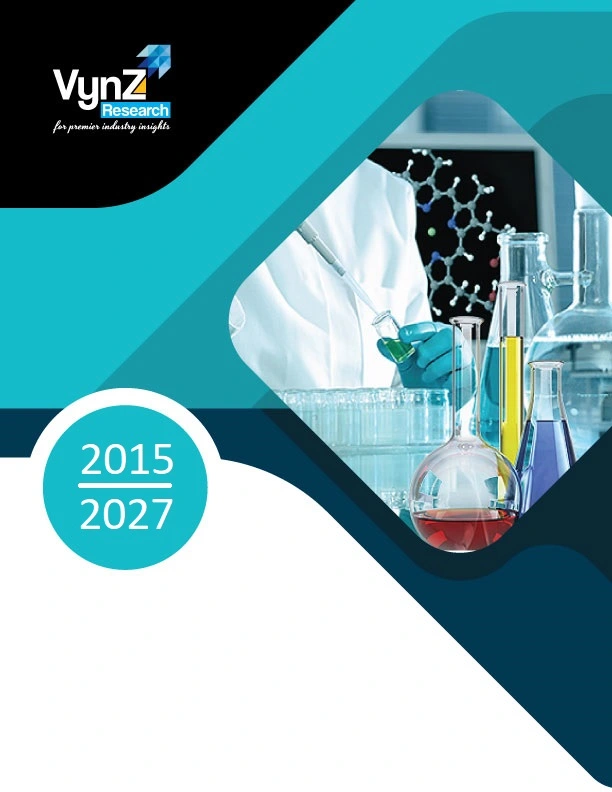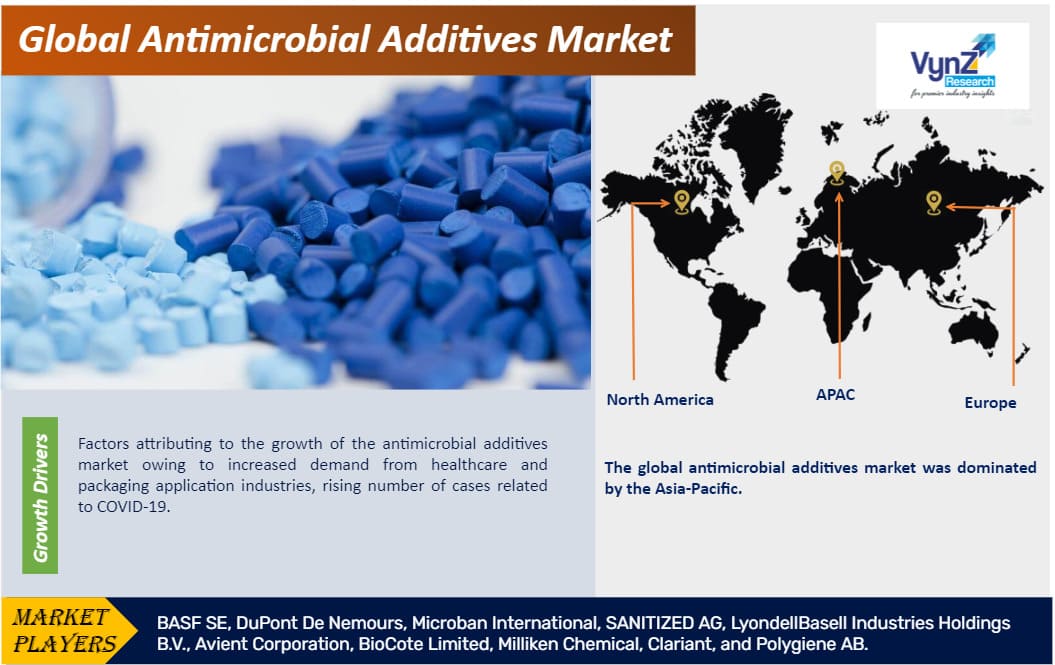| Status : Published | Published On : Dec, 2024 | Report Code : VRCH2085 | Industry : Chemicals & Materials | Available Format :

|
Page : 250 |

Global Antimicrobial Additives Market – Analysis and Forecast (2025-2030)
Industry Insight by Type (Inorganic Antimicrobial Additives and Organic Antimicrobial Additives), by Application (Plastic, Paints & Coatings, Pulp & Paper, Ceramics, and Others), by End Use (Healthcare Industry, Packaging Industry, Food & Beverage Industry, Building & Construction Industry, Automotive Industry, Textile Industry, Consumer Goods Industry, and Others), and Geography (North America, Europe, Asia-Pacific, Middle East, and Rest of the World)
Industry Overview
During the projected period 2025-2030, the global antimicrobial additives market is expected to increase at a CAGR of 6.7%, from USD 3.8 billion in 2023 to USD 5.9 billion in 2030.

Antimicrobials are any product or material infused with antimicrobial agents and additives that prevent infection and fever-causing microorganisms including bacteria, fungi, algae, yeasts, mildew, and other parasites from growing. Microorganisms that thrive on untreated particles generate discoloration, foul odors, and polymer degradation. Antimicrobial chemicals prevent these germs from growing in the final product. Dimensional stability, heat, and chemical resistance are all improved by antimicrobial additives. The increased adoption of antimicrobial additives products in the aviation, construction, packaging, marine, and food & beverage industries along with increased awareness among consumers about health-related issues will accelerate the development of the antimicrobial additives market.
Antimicrobial Additives Market Segmentation
Insight by Type
Based on type, the global antimicrobial additives market is bifurcated into inorganic antimicrobial additives and organic antimicrobial additives. The inorganic antimicrobial additives contributed to the largest share of the market during 2025-2030. The increased demand for inorganic additives in a variety of applications like textiles, paints, polymers, and coatings to prevent the spread of germs and bacteria will bolster the growth of the market. They also reduce the bioburden in areas where unchecked microbial growth may result in food poisoning or fatal infections. The increased consumption to destroy genomic and plasmid DNA of organisms will contribute to the growth of the market. Furthermore, it offers superior protection like copper salts are used in several preservatives and sterilized applications offering antimicrobial additives.
Insight by Application
Based on application, the global antimicrobial additives market is segregated into plastic, paints & coatings, pulp & paper, ceramics, and others. Plastic applications contribute to the largest share in the antimicrobial additives market as it is used for counter degradation and discoloration in roofs, pipes, flooring, insulation, and vinyl slides. Plastic's increased vulnerability to microbial growth, as well as its extensive utilization in the production of food containers, soap dispensers, breathing devices, and surgical goods, has fuelled the demand for antimicrobial additives. Market growth will be aided by increased penetration of sports equipment, electronic parts, and automobile interiors.
Insight by End Use
Based on end-use, global antimicrobial additives are classified into the healthcare industry, packaging industry, food & beverage industry, building & construction industry, automotive industry, textile industry, consumer goods industry, and others.
The food & beverage industry is projected to have considerable growth owing to the continuous adoption of additives in flooring, shelving, ice-making machines, food processing equipment, water coolers, storage containers, and water hydration systems, thereby bolstering the growth of the antimicrobial additives market.
Global Antimicrobial Additives Market Report Coverage
|
Report Metric |
Details |
|
Historical Period |
2018 - 2023 |
|
Base Year Considered |
2024 |
|
Forecast Period |
2025 - 2030 |
|
Market Size in 2024 |
U.S.D. 3.8 Billion |
|
Revenue Forecast in 2030 |
U.S.D. 5.9 Billion |
|
Growth Rate |
6.7% |
|
Segments Covered in the Report |
By Type, By Application, and By End -Use |
|
Report Scope |
Market Trends, Drivers, and Restraints; Revenue Estimation and Forecast; Segmentation Analysis; Impact of COVID-19; Companies’ Strategic Developments; Market Share Analysis of Key Players; Company Profiling |
|
Regions Covered in the Report |
North America, Europe, Asia-Pacific, Middle East, and Rest of the World |
Industry Dynamics
Industry Trends
The increased technological development in the chemical industry, increased demand for better-performing products in the healthcare sector, increasing manufacturing of medical devices and equipment involved in the use of antimicrobial additives, initiatives by the government to fund the operations of the medical manufacturing industry, and the need for seamless and stain-resistant packaging of goods are the key trends in the antimicrobial additives market.
Antimicrobial Additives Market Growth Drivers
Factors attributing to the growth of the antimicrobial additives market owing to increased demand from healthcare and packaging application industries, increasing threat of bio-resistant in patients owing to administration of antimicrobial drugs, and rising cases of pathogen transmission owing to human-to-human contact will propel the growth of the market. Antimicrobial additives are adopted by automotive manufacturers like Ford Motors to manufacture cars and are also used in the textile industry used by HeiQ. Moreover, the increasing geriatric population, increased demand from emerging markets, and growing usage of silver-based products as antimicrobial additives will further propel the growth in the market. The increasing number of nosocomial infections and life-threatening diseases in current times has led to increased awareness among consumers about their health.
Antimicrobial Additives Market Challenges
The fluctuating raw material prices may hinder the growth of the market and producers and manufacturers will produce according to the demand. Also, stringent environmental regulations may restrain the growth of the market. The increased adoption of antimicrobials may pose a risk to the environment and animals, such as antimicrobials released into aquatic settings where they can bioaccumulate in marine food webs, which will pose challenges to the Antimicrobial Additives Market over the projected period.
Antimicrobial Additives Market Opportunities
The untapped opportunities for the adoption of antimicrobial additives in the agriculture and cosmetic industry and emerging markets will propel the growth of the antimicrobial additives market. Furthermore, the increasing R&D activities, technological development, and modernization in production techniques will offer promising opportunities for growth in the global antimicrobial additives market during the forecast period 2025-2030.
Antimicrobial Additives Market Geographic Overview
Asia-Pacific contributes to the largest share of the antimicrobial additives market owing to strict industrial standardizations related to increased adoption in end-use industries in developing countries like China, India, and South Korea. Furthermore, rising healthcare regulations in hospitals and medical facilities, increased demand and policies such as emission control and use of environmentally friendly products and a rising population have created promising opportunities for the antimicrobial additives market.
North America is anticipated to have moderate growth during the forecast period as it has well-developed healthcare infrastructure and reimbursement coverage plans that can cater to increased demand for developed healthcare services, thus propelling growth in the region. Furthermore, the rising population and increasing number of car accidents will increase the demand for surgeries, the robust packaging industry in Canada, thus driving the demand for the antimicrobial additives market.
Antimicrobial Additives Market Competitive Insight
The industry players in the antimicrobial additives market are making innovative product launches that can be used in masks, protective apparel, etc. The segment's growth would be aided by market participants' increasing attention to incorporating antimicrobial additives to reduce contamination problems in healthcare. Also, the adoption of inorganic strategies like partnerships, M&A along with capacity expansion will allow the industry players to sustain their position in the competitive market.
Recent Developments By the Key Players
Microban International and CiCLO Technology have partnered to build sustainable performance functionality into synthetic fibres, yarns and fabrics.
Archroma, a global leader in color and specialty chemicals, has continued its longstanding partnership with SANITIZED AG, marking collaborative success in the textile industry.
- BASF SE
- DuPont De Nemours
- Microban International
- SANITIZED AG
- LyondellBasell Industries Holdings B.V.
- Avient Corporation
- BioCote Limited
- Milliken Chemical
- Clariant
- Polygiene AB.
.png)
Region Covered in the Report
• North America
- U.S.
- Canada
- Mexico
• Europe
- Germany
- U.K.
- France
- Italy
- Spain
- Russia
- Rest of Europe
• Asia-Pacific (APAC)
- China
- Japan
- India
- South Korea
- Rest of Asia-Pacific
• Rest of the World (RoW)
- Brazil
- Saudi Arabia
- South Africa
- U.A.E.
- Other Countries
Frequently Asked Questions
Purchase Options
Latest Report
Research Methodology
- Desk Research / Pilot Interviews
- Build Market Size Model
- Research and Analysis
- Final Deliverabvle
Connect With Our Sales Team
- Toll-Free: 1 888 253 3960
- Phone: +91 9960 288 381
- Email: enquiry@vynzresearch.com
Antimicrobial Additives Market
